
Miramichi Early Season Salmon Report
Fishing Friends –
The early season in review – I’m back from nearly a month in my camp at Campbell’s Pool in Blackville – the joys of retirement… In summary the run of salmon through the first few days of July on the Miramichi – the early run – felt more substantial than recent years, but the fish weren’t any easier to catch. In June we had the seemingly wonderful scenario of a moderate height of cool water refreshed regularly with substantial but not excessive rain events. The salmon’s reaction to this was to book it upriver without stopping to take flies. Byron Coughlin of Country Haven and I were talking about this. He said that in all his years of outfitting on the Miramichi, that the frequently observed behavior of not taking flies until they got above the mouth of the Cains River was demonstrated more clearly to him in 2019 than in any previous year he could remember. In fact we heard reports of that all the way up to and beyond Doaktown, though Country Haven’s Pools in Upper Blackville seemed to do quite well on many days.
During much of June we would see the occasional fish jump or roll as it entered or exited a pool. Much more often than I can remember we would occasionally look down from the canoe while working through a pool and see an actual school of salmon moving up the river along with the shad and gasperaux – which themselves reportedly had a better run this season than in most recent years. We rolled and pricked a handful of fish between the 12th and 21st, but did not net a fish at Campbell’s until June 22nd when Pete Howell got a nice 22-pound salmon at Doctor’s Island to start our season off. He also got a grilse the next day at Keenan’s. I compared notes with a few other camps below the Cains and the story was more or less the same at all of them.
During the last week of June, and the first day or two of July, we had quite good fishing with everyone in camp hooking and landing salmon and/or grilse. One evening I solidly hooked 4 salmon in a little over and hour. All the fish were along the edge that I was wading – as opposed to holding out in the pool. Clearly a good number of salmon were moving through the pool that evening, but we never saw a single salmon or grilse jump on its own. That is really unusual. I guess that the fish just had their heads down and were focused on getting further up the river. On other days, though, we saw a few fish regularly leap out on their way upstream. I can tell you that the amount of grilse that we saw was definitely greater than in other recent seasons.
When the June 30 fish counts from the government fish trap at Millerton came out I fully expected substantially more salmon and especially grilse than in other recent years. It wasn’t the case though. Salmon numbers were down somewhat from last year, though within the historic range, and grilse numbers were almost double the year before, but still less than 50% of what they averaged between 1990 and 2014. One possible contributing factor to lower than expected Millerton numbers is that we had large runs of both gasperaux and shad this year. I have heard that salmon don’t like to get near the trap if it has a lot of other species in it. Mark Hambrook recently said in the MSA weekly broadcast that trap numbers in early July have been very good for both salmon and grilse. I’ll do another blog on those numbers sometime after July 15 when the latest statistics are released.
Since leaving I’ve been getting regular e-mails from Jason Curtis of Blackville, head guide at Campbell’s. Jason has found a couple of occasions to get out fishing in the last few days. The recent rains have cooled the river a little and the increased water height and corresponding flow have created a pretty good run of fish. He got a lovely large grilse on 7/12, and three grilse the evening of the 7/13. Two of them he said were extra-large specimens. I also see a lot of positive chatter on Facebook regarding catches over the last couple of days. It is sure great to see.
We have yet to see a lot of larger salmon, instead the run seems to be largely made up of grilse and smaller to medium-sized salmon. If this is a good indicator of better at sea survival then we will take it. There is plenty of season coming yet for us to see numbers of big, repeat spawners. I also noted that in the cool early water we saw very few parr. As things warmed up, though, more and more parr were present in the normal places, and I ended up feeling that things are more or less normal in that regard.
In the Dungarvon barrier reports grilse were virtually identical to last year while all three sizes of salmon were up. The total count was also up about 10% over last year. Of note too, is that the number of sea run brook trout in the Dungarvon River so far this year is up many fold over last year. These are good signs for the future.
Near term fishing prospects – Water in the Miramichi at this time is constantly on the edge of being too warm for salmon fishing. A nice raise of water like the lower Miramichi has right now – the bulk of the storm missed the Juniper headwaters but poured on Bantalor at the head of Cains – brings in fish, and things are good for a time. We have some serious heat coming in for mid-week, but we also have another rain event. If you have the time to spend on the river you can find some good fishing, but it is punctuated with some less productive time.
Anything new in equipment or flies – If there are any really important new developments I’m not aware of them. I’m sort of rediscovering some old fly patterns like the John Olin which is essentially a Black Bear with a gold body and tag rather than floss and the addition of a golden pheasant tail as on a Silver Rat – which, by the way, also worked well for me this summer. In the big June water we got away with #2s and #4s which really help you to hold on to an acrobatic fish. Jason tells me that in the high water last evening he was using a #2 Green Machine with a white tail, undoubtedly tied by Ashley Underhill of Blackville. If anything works, a green machine will probably work.
Conservation discussions – While things seem moderately upbeat on the Southwest Miramichi this year it does not appear that the NW Miramichi is quite as blessed. Both salmon and grilse numbers there are among the lowest ever recorded. Why? No one can be sure of the reasons, but the NW has the highest density of spawning striped bass, and it has taken the brunt of First Nations fishing. It was quite sobering for me during striped bass fishing on the NW to see a beautiful bright May salmon held up bloodied and dead by a First Nations angler, and then for the fish to appear later that evening on Facebook, displayed all steaked up in a big pan flanked by not only the angler, but also a First Nations warden!
Quite a controversy is raging over the proposed CAST program. A collaboration of The University of New Brunswick, Canadian Rivers Institute, Irving, Cooke Aquaculture, and the Miramichi Salmon Association want to go ahead with the program of releasing adult salmon in the fall to spawn with wild fish. These adult salmon are raised in the MSA hatchery from totally wild smolts captured two years previous in the same Miramichi branch into which they will be released to spawn naturally. The Department of Fisheries and Oceans hasn’t yet given it the green light. I’m not a fishery scientist, but it certainly seems to me that the facts are on CAST’s side. Every bit of data that turns up seems to support the positions of CAST, and the immediate plan is to deploy that technology in the NW first – where it is clearly most needed. If this year continues as it seems to be headed over there, the need for the program should become overwhelmingly clear.
Here is a link to Dr. Tommi Linnansaari explaining the CAST SAS program.
The MSA – Meanwhile the Miramichi Salmon Association’s historic conservation programs of stocking young fry spawned from wild fish, and addressing habitat issues like clearing beaver dams and enhancing cold water inflows continue to receive attention. As many of you know the Cains River is especially close to my heart. This spring 17,500 early feeding fry were stocked in brook and stream locations like both branches of the Sabbies River, Salmon Brook, Muzzeroll Brook, and both branches of Six Mile brook. This puts fry into areas that in some years may not see any spawning activity at all due to low water and beaver dams. The fry were spawned from the eggs and milt of wild fish that were caught from pools on the Cains River last fall. After spawning in the hatchery the fish were returned to the wild where hopefully they will survive and return again to the river on another spawning run. The benefit of this process is first, that the number of surviving eggs from the hatchery is many times greater than in the wild where the whims of nature can simply wipe out an entire redd, and secondly, as stated above, the fry can be placed in areas that for various reasons have not been reached by spawning fish.
As always, don’t hesitate to comment or ask a question. Thanks, Brad Burns


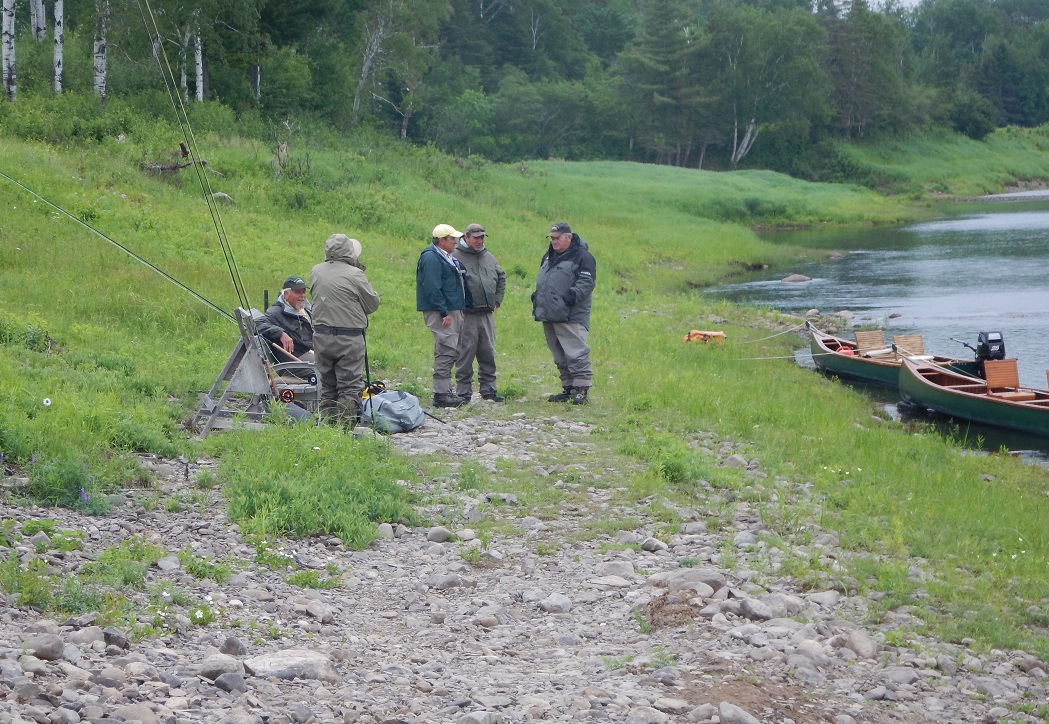
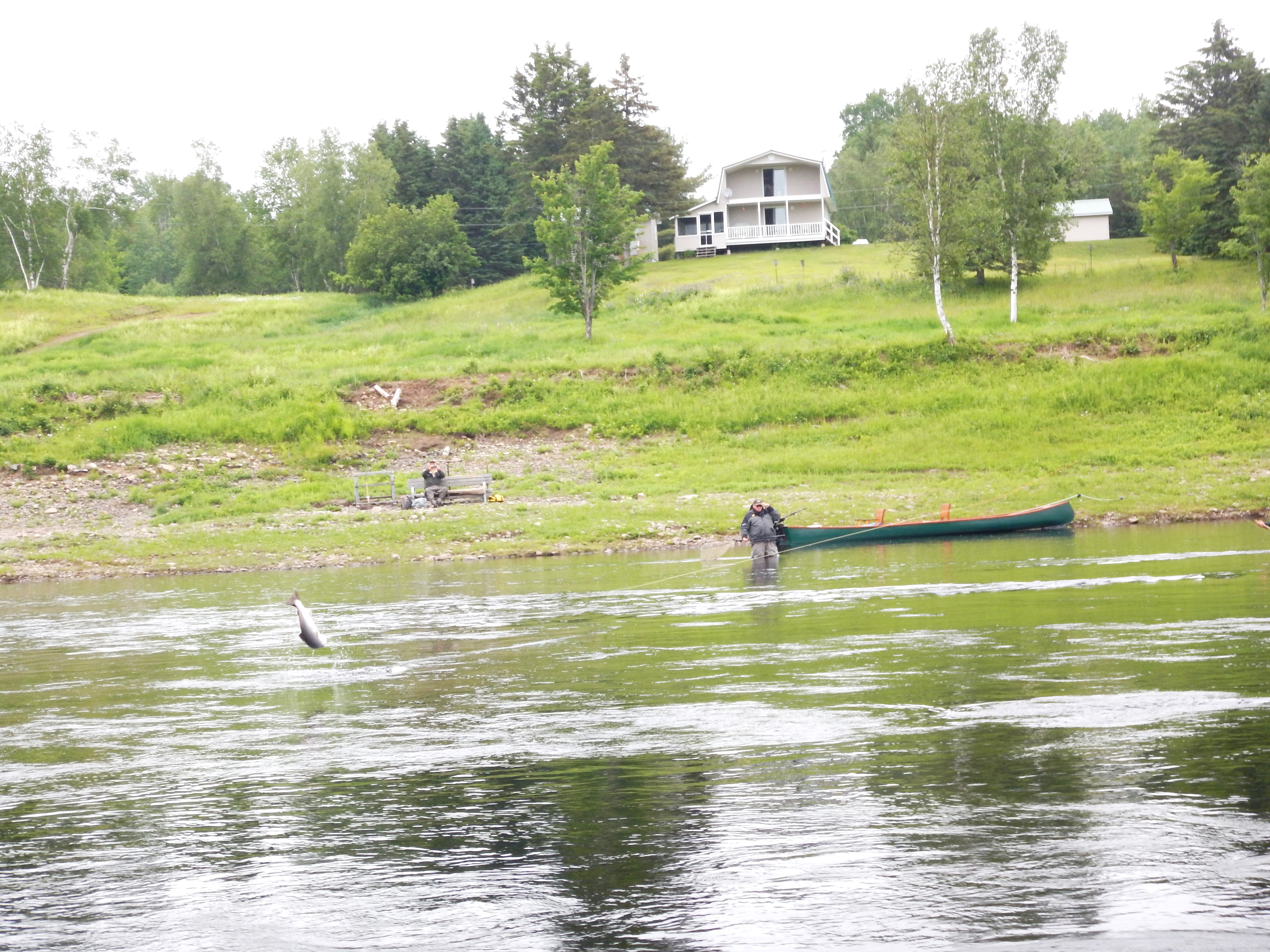
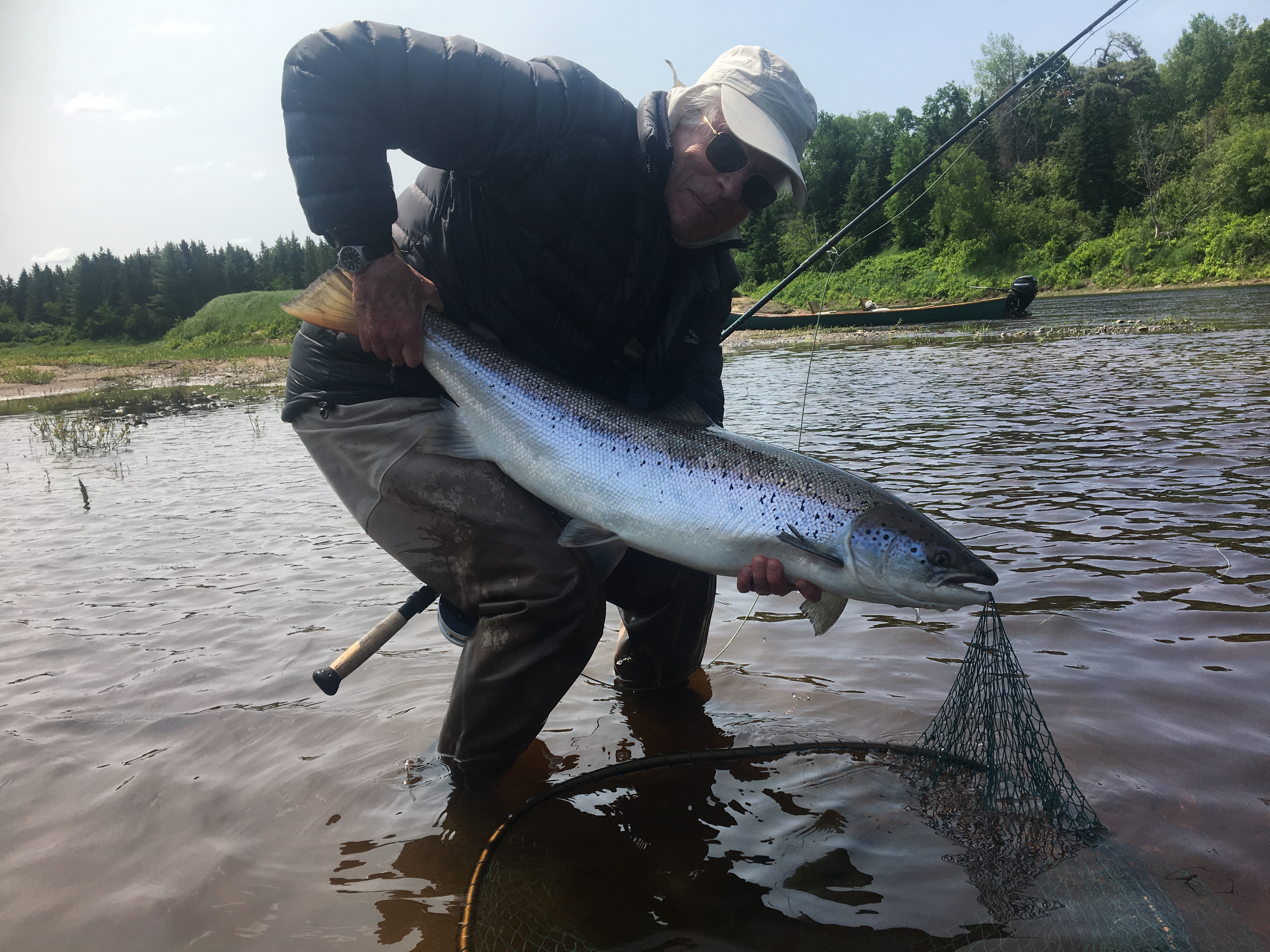
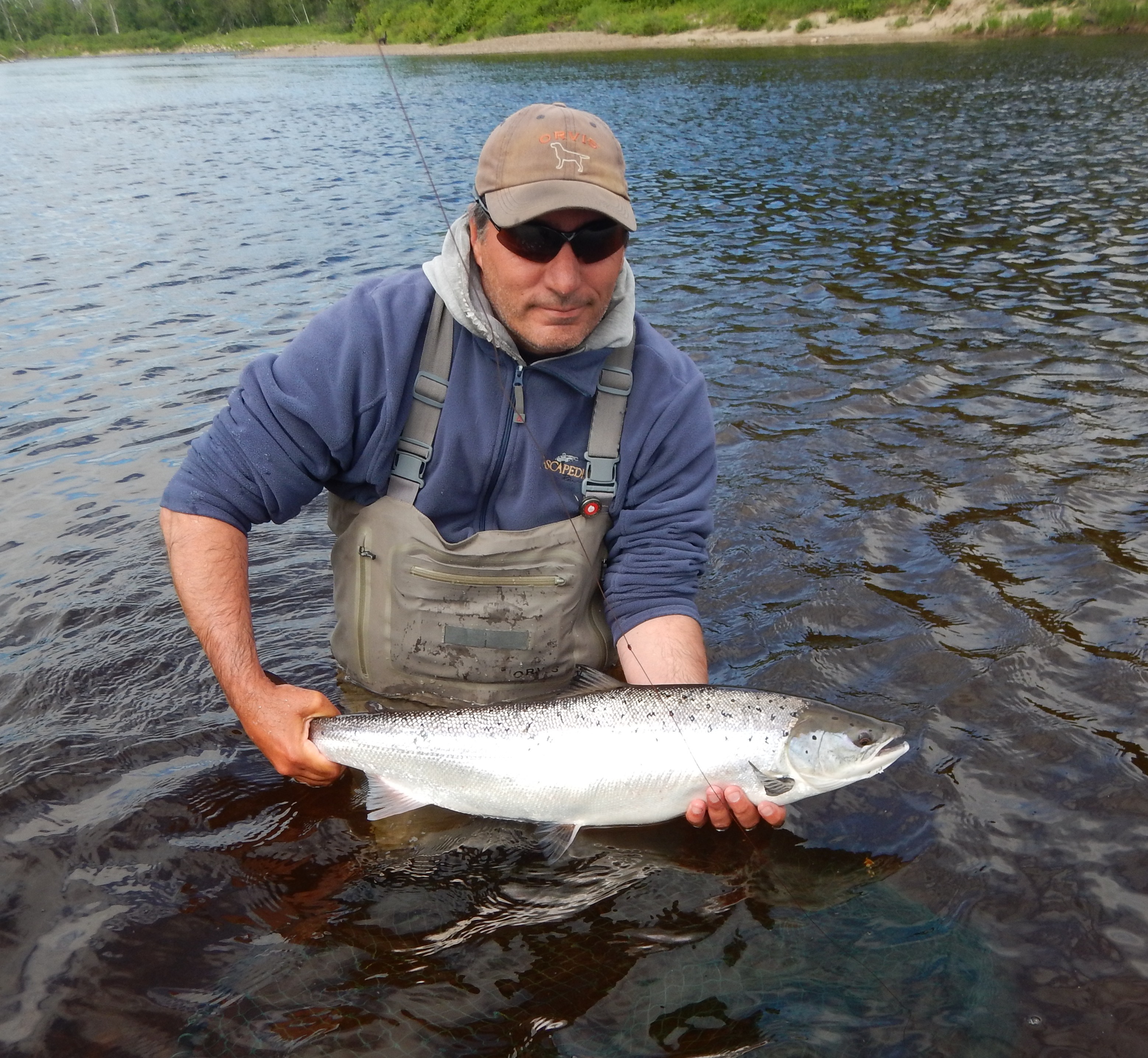
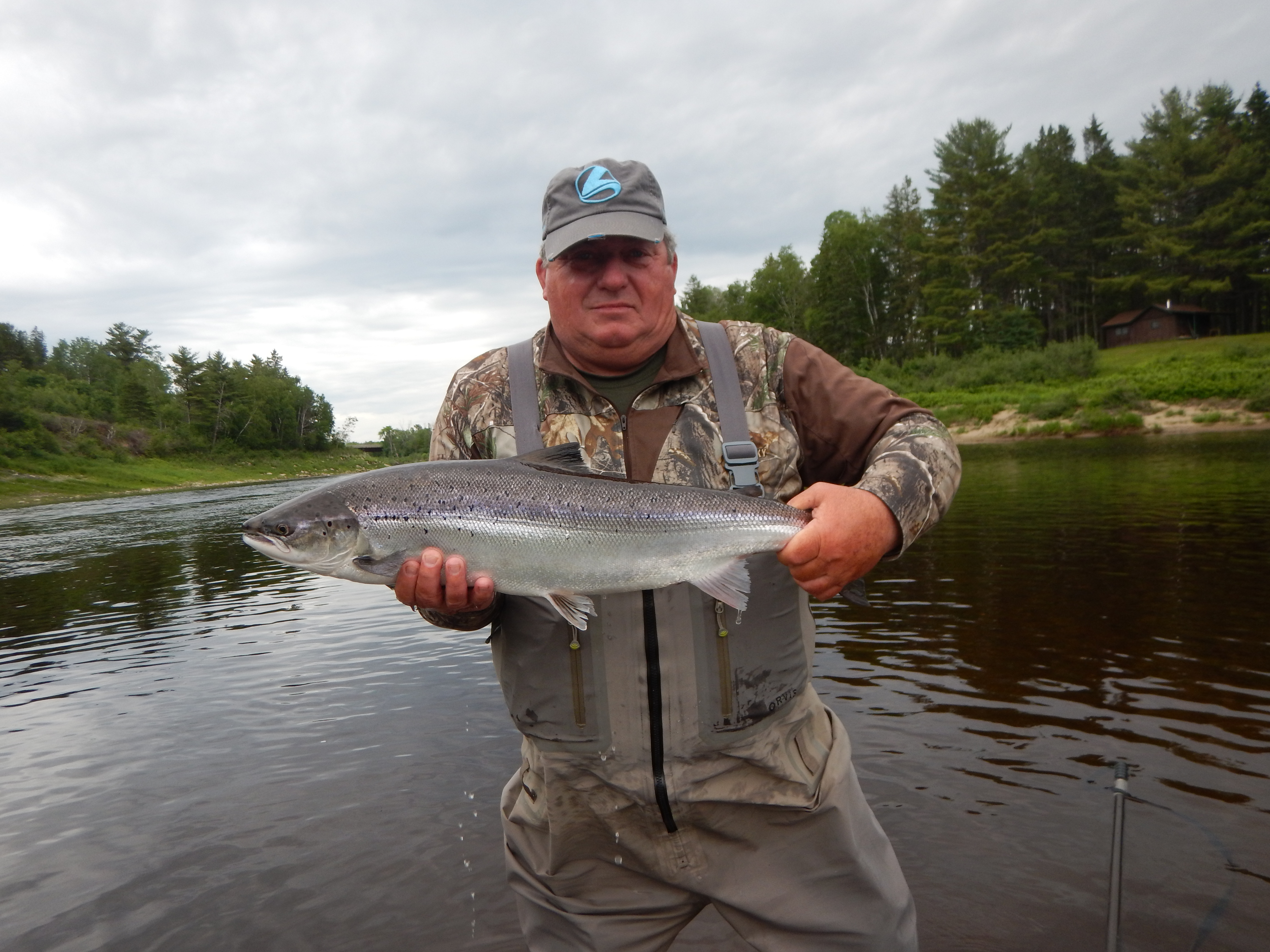

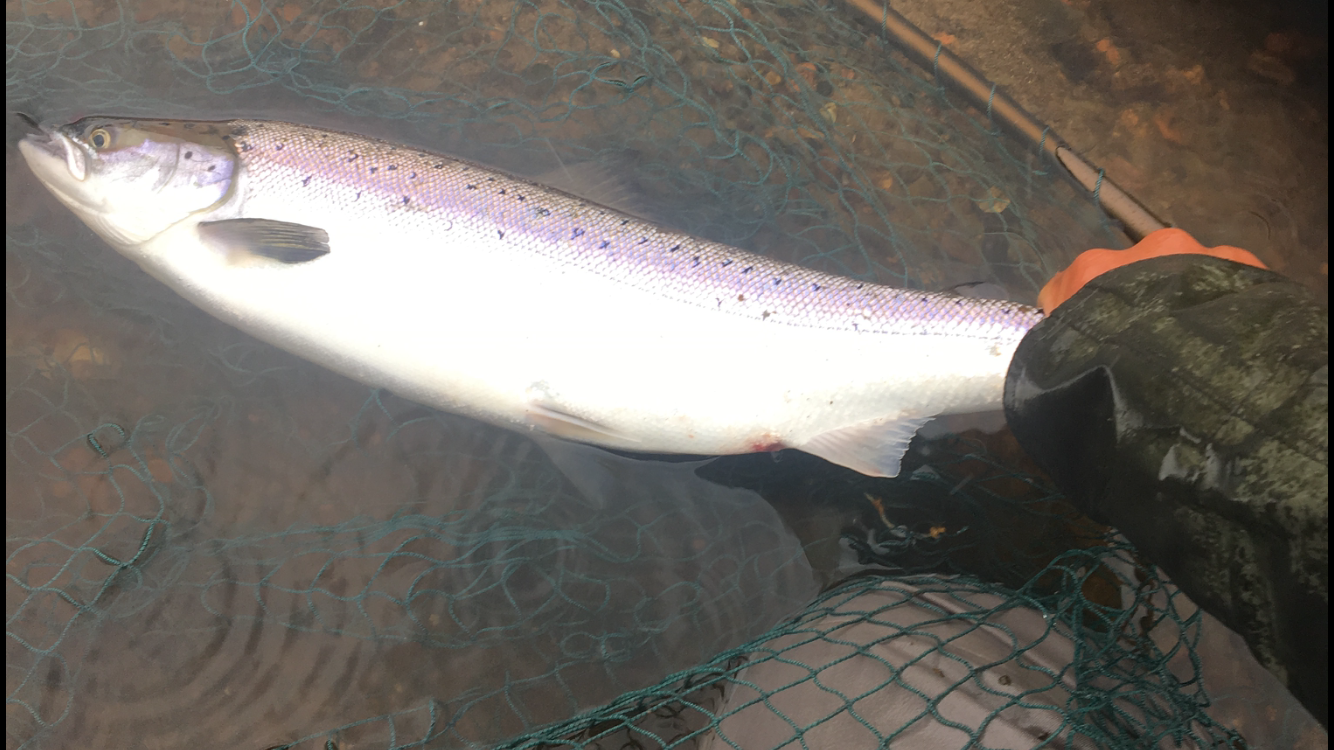
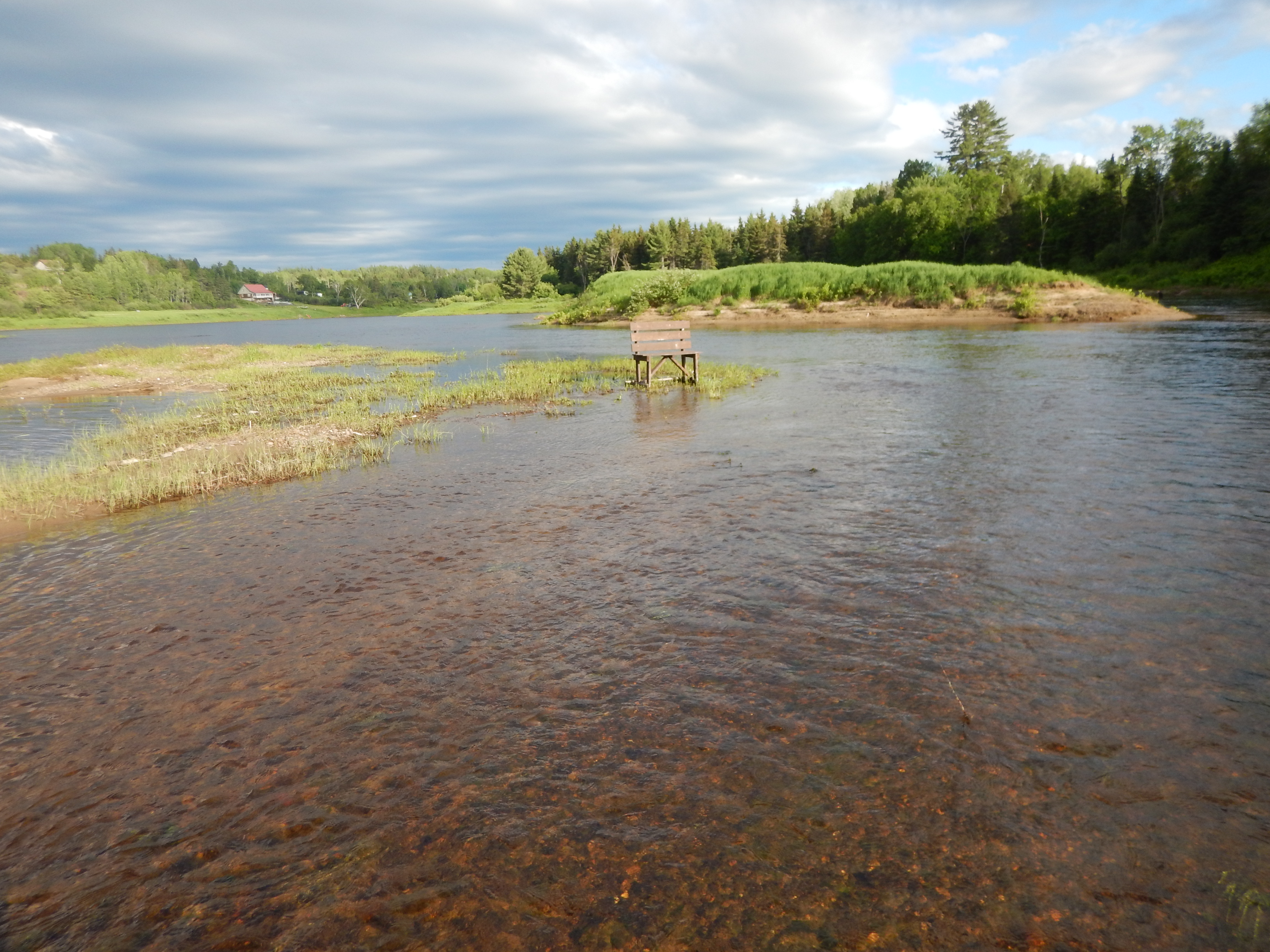
Thank you for a very thorough and detailed report.
Brad,
Once again reading your salmon blog brings back such fond memories of my June salmon fishing.
These early summer fish certainly are beautiful.
I hope your season is a great one.
Kal
Eagerly await your updates. Looking forward to your next publication.
wonderful article, I always enjoy the updates from you.
Ken Cogswell
Ken – thanks and don’t forget that I have a print of the map of the Cains for you over at Campbell’s. I could have it delivered to Doaks or someplace anytime that you want. Thanks for the support of MSA at that auction. Brad
Hi Brad. I picked up my copy of the Cains map in June and I’m awaiting completion of my renovated “man cave” before I frame it and put it up. It is very nice. Thanks for organizing delivery. I’m looking forward to the book, of course. I fished the MSW July 2-6 and picked up one nice grilse only. Two days of very hot weather had the bite turn off though we saw salmon and grilse nearly every day. I fished the Restigouche July 7-13 and we did well with good flows and perfect temperatures. We got a good number of fish (largest 29 pounds) and saw lots of activity. It is all about timing, right? I’m hoping the “normal” New Brunswick summer weather mix we’ve seen so far will persist and that will make a big difference in the salmon runs in 2019. The last two summers of high temps and lack of rain almost guaranteed poor summer fishing in my view. All the best, look forward to your next report.
Brad, Thank you so much for the update. The news sounds very encouraging. Every day, I look forward with great anticipation to getting back to the Miramichi in September.
Hi Brad,
I’ve been following your daily fishing reports and certainly enjoyed your summary post. It’s very encouraging to read of improved fish numbers and good water conditions. Hope you have an excellent season and look forward to future posts. Any update on your new book?
Larry Gaska
Thanks Larry, and yes, the new book is finished in editing and has proceeded to layout and design. I’m still expecting copies around Thanksgiving. I’ll be making an advance offering to all of my blog followers. Brad
Thanks for the update Brad, nice to see Doctor’s Island producing big salmon. Hope to see you before the end of the season, Guido
Great to hear from you Guido. Pat and I weren’t so lucky – too hot.
Future comments will post automatically, just the first one for an e-mail address needs to be approved. Thanks for commenting.
Brad, I also enjoyed your article and the wide range of topics you covered. Great to hear there is a glimmer of hope in salmon returns. Increasing there odds of survival and returns requires all the help possible and the CAST program needs to be part of that. I find it both surprising and disappointing that the Department of Fisheries and Oceans put up roadblocks to this program. They should be willing supporters and participants. They have forgotten that they work for us, the tax payer. The Politicians should seize this opportunity to increase the salmon survival returns and research, not to mention increasing their own support for election/re-election.
Agreed on all points.
Hi John. The hesitation on the part of DFO is because they understand there is a real risk of causing more harm than good. On the NW the situation is so bleak that it calls for desperate measures and this CAST program is just that. If a fish does not live in the wild it loses it’s instinct(s) necessary for survival. A fish raised in captivity has reduced instincts that will be passed onto progeny. Wild/wild progeny have the strongest instincts. Wild/tank raised crosses produce fish with less strong instincts and therefore less fitness. It is possible that this program takes the last potentially wild/wild crosses and replaces them with dumber fish produced from the wild/tank raised crosses. This is how this program could cause more harm than good. Remember there is nothing so dangerous as someone whom is sure they are correct.
On the west coast they have found that in six generations of stocking the fish lose all instincts necessary for survival. That is 20% loss per generation or 20% less fit. We need to have some humility in our management of salmo salar and realize there is much we do not know.
Love your post Brad. I was thinking that the fish must be up to Brophy Pool by now with the water so high. Wonder if you have been in there lately? Kevin Anthony
Kevin – there have been fish at Brophy now for a couple of weeks. When I left there two weeks ago we had made a couple of trips in and had seen just a few, but I understand that more have been holding there, recently. All the cold water brook pools are being closed as of today, and I imagine that with the coming heat a lot of fish will take refuge there. One new change for this year is that DFO is closing all the pools on the list on both sides of the river. Brad
I, too, find it disappointing that Fisheries can’t get on board with the CAST program, especially on the NW, where it seems most needed this year and seemingly can’t hurt. Thanks for the thorough report.
Brad, a fine report. Thanks. Now some comments…
The CAST program, although good in concept has been poorly rolled out and presented. I was at a meeting called by MSA last fall for camp owners to “Address Striped Bass and low adult salmon returns”.
Although there was a bit of discussion of stripers, the gist was about CAST. That gist was presented by Jim Irving. I like the concept, but here are the problems as I see them:
– MSA and CAST did not initially engage the First Nations for their support of this program. A poor political and tactical choice. They tried to simply push it through as the fish were ready to release. Without First Nations concurrence DFO has “cover” to just say “no”.
– At the meeting I also addressed what I view as other important parts of the declining salmon matrix: forestry practices. I have been fishing the Miramichi for 50 years, pretty much continuously. From what I see the Province’s forestry practices, although legal, are devastating to long term salmon habitat. Specifically, clear cutting. The massive clear cutting in the province leads to erosion, siltation, diminishment of water retention capacity of the land resulting in more rapid rise (and fall) of river flows, and generally higher water temperatures. I am seeing these results each year, and they do not seem to get better. In the past there were a few episodes of warm water, now it seems to become a new norm.
This is where Irving has a chance to demonstrate real leadership as an active business that is politically engaged and as a conservation leader. I wish they would. CAST is a nice idea, but a band aid. The problems are far more severe as habitat is first, exploding striped bass populations and CAST trail. Without habitat the Miramichi will become a bass river with a few salmon.
Well said, Howard
My only addition to both Ed and Howard’s comments is that while I was not an important part of the CAST program, I was on the MSA board during that time. I listened to Mark Hambrook discuss the program on several occasions. I do know that they tried to get First Nations to be involved in the process. I don’t think that is always as easily done as one might think. I don’t believe the strategy was ever to wait until the last minute and try to ram it through, but it may well have seemed like that because the growth of the fish creates a fixed schedule and ultimately a deadline.
My personal thoughts on any stocking program of any kind are that the Miramichi is one of the world’s greatest runs of spawning gravel, and that spawning or even the number of smolts produced still doesn’t seem to be the problem – it is how many are making it through the bass and/or back from their time at sea. That being the case how will any spawning enhancement scheme help? I have come around to thinking, though, that while it is a band aid, and the ultimate goal is to let the river do its own thing, that as Dr. Linnansaari has said, this is a supplemental program to help when needed.
There have been some recent statements attributed to DFO – accurate or not I don’t know – that the SAS program can be tried after the native population in the river has become extinct. I would sure hope that wasn’t truly their attitude.
Well said, Howard.
Ed, and any other new commenters. When you make your first post I have to manually approve it. Once I have done that, though, any future comments are automatically approved as you make them. I think it is the easiest and simplest way to handle it. Brad